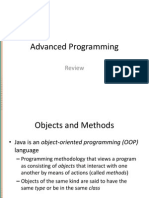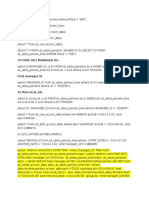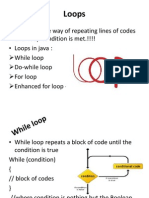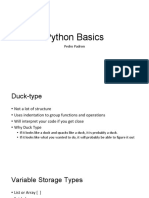A Java class can be defined as a template or
blueprint which describes state/behavior of its
object.
In Other Word a class is used to create Objects.
�Creating a class
A class is declared by using the keyword
class. E.g.
public class Tree
{
//This is our Tree class
//All codes goes here
}
� Objects are nothing but the instance of the
class.
A single class can create any number of
unique objects.
�Creating objects
In java an object is created when someone
says new.
At each new , a new object of a class is
created. E.g.
new dog();
new tree();
new student();
� Objects lives in Java heap.
What is java heap?
Java heap is nothing but the memory space taken by JVM
from the OS.
All objects are created in this heap(space). Whenever
JVM encounters new keyword, it creates an object in
heap.
When there is no space in heap to create objects, then
JVM throws Out of Memory error.
�Creating First Object
public class Student
{
public static void main(String[] args)
{
new Student();
}
}
�Garbage Collection
Garbage Collection is the mechanism provided
by JVM, to clean out the Heap, so that new
objects can be created.
It destroys the objects which are not in use
or eligible for garbage collection.
Any object is said to be eligible for garbage
collection (GC) if there is no Reference
Variable attached to it.
So what is a Reference Variable??????
�Java Variables and its type
Variables are named space of memory which
stores the data.
There are two types of variables :
Primitive variables
Reference variables
Reference variables are those variables which
stores only address of an object.
�Assigning Objects to Reference Variable
Before creating a reference variable we have to specify
object of which class it is going to refer.
In other word we need to specify the class type of
the reference variable. E.g.
public class Test
{
public static void main(String[] args)
{
Test t = new Test();
//where t is the reference variable which stores the
Address of Test object in heap
}
}
�Primitive and Non primitive datatypes
Primitive Datatype
Primitive datatypes are
defined by the
programming language.
These are
Integer type
Floating type
Character
Boolean
Non-Primitive Datatype
Non-Primitive (or
Reference) datatype are
defined by programmer.
In this the datatype of the
variable is the Class whose
object it is going to refer.
Test t = new Test();
//where Test is the datatype of
t
�Declaration and initialization of
primitive variables
Integer
int i = 234242425;
long l = 284798247287427427428947l;
//suffix l is must otherwise compiler will treat it as integer.
Float
float = 2342.34f
//suffix f is must otherwise compiler will treat it as a double
double = 298472847242478927.2942949274
Character
Char c = j; // only single character is allowed
Boolean
Boolean b = true // only true or false is allowed
�Java String and String Concatenation
In java String is a class and not a datatype and it can
be instantiated like other classes
String s = new String();
String Concatenation is basically a way to combine two
or more strings into a single string. This is done by
using + operator.
String s = We + are + learning + java + .
String values can be concatenate with any other
datatype.
boolean b = true;
String s = this is + + b
�Arithmetic operators
+ additive operators/string
concatenator
- subtraction operator
* multiplication operator
/ division operator
% remainder operator
Unary operators
++ increment operator
-- decrement operator
! logical compliment
operator
�Java Operator Continues
Equality and Relational
== Equal to
!= Not equal to
> Greater than
< Less than
>= Greater than or equal to
<= Lesser than or equal to
Conditional Operators
&& Conditional And
|| Conditional Or
?: Ternary Operator
�Ternary Operator
The ternary operator or ?, is a shorthand if else
statement. It can be used to evaluate an expression
and return one of two operands depending on the
result of the expression.
boolean b = true;
String s = ( b == true ? "True" : "False" );
Or the above can be written as
boolean b = true;
String s;
if(b == true){
s = "True";
}else{
s = "False";
}







































































































